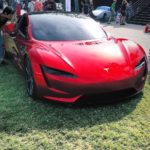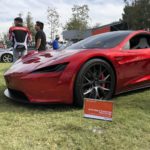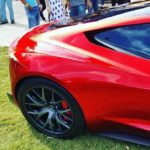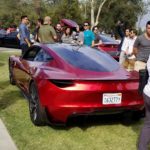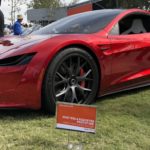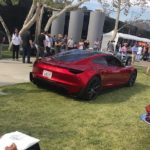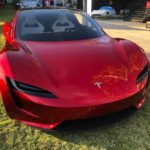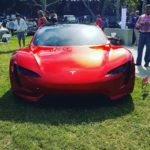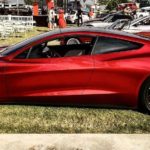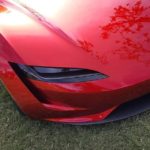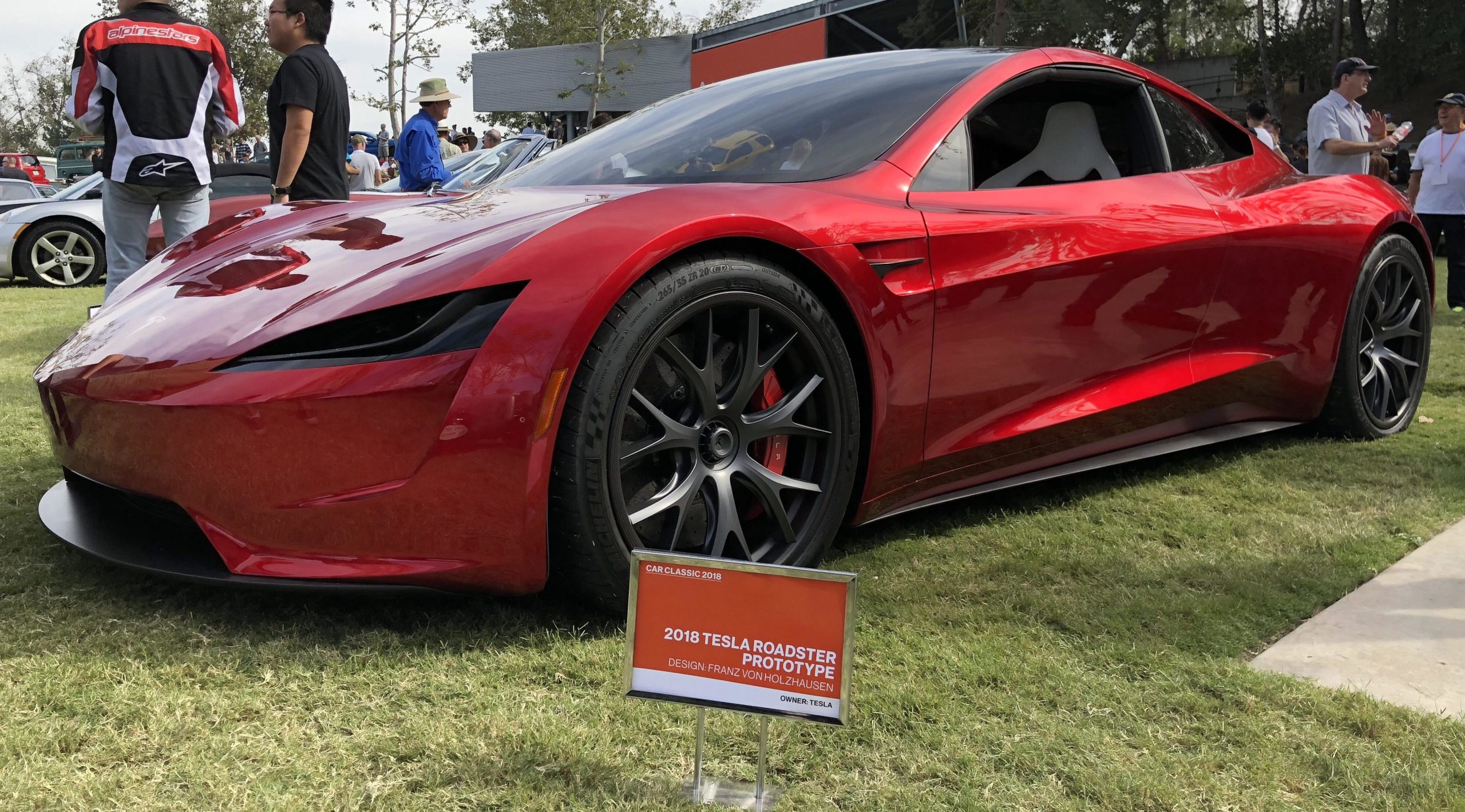
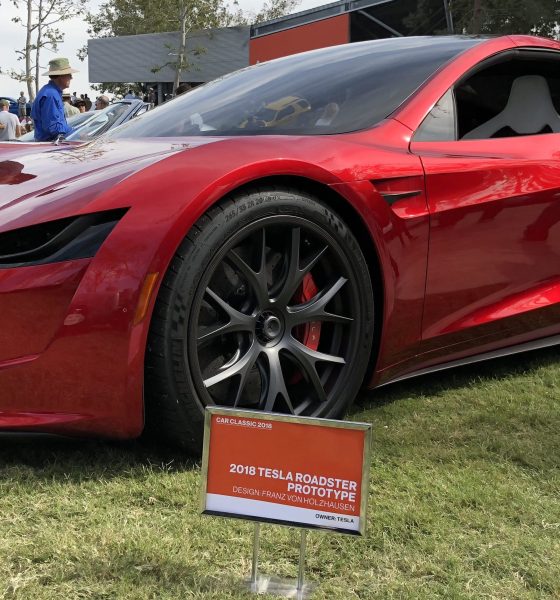
News
Tesla’s next-gen Roadster stuns crowd at famed ArtCenter in Los Angeles
In the world of supercars, there are vehicles that always warrant a second look — cars that are so attractive and iconic; they end up lining the bedroom walls of enthusiasts in their formative years. Decades ago, that car was the Lamborghini Countach and the Ferrari Testarossa. Today, amidst the advent of the electric era, that car is the next-generation Tesla Roadster — a vehicle that Elon Musk aptly dubbed as a “hardcore smackdown” to fossil fuel-powered automobiles.
Tesla’s next-gen Roadster prototype made a rare appearance in Los Angeles over the weekend at the ArtCenter College of Design’s Car Classic 2018 exhibition. The weekend event celebrated the 70th anniversary of the College’s Transportation Design program, which has produced some of the world’s most iconic designers, including Tesla Chief Designer Franz von Holzhausen and Tesla’s Director of Product Design, Javier Verdura. Both are alumni of the Southern California-based ArtCenter who became friends in the early 90s while attending the school’s design program.
Several high-profile vehicles were showcased alongside a gorgeous red Tesla next-generation Roadster at Sunday’s annual car classic, including Henrik Fisker’s EMotion all-electric sports car, a Michelle Christensen-designed Acura NSX, and a Sasha Selipanov/Chris Ha-designed Genesis Essentia concept car.
Attendees of the exhibition took to social media to share stunning images of Tesla’s upcoming all-electric supercar.
- The next-generation Tesla Roadster at Car Classic 2018. [Credit: t35l_4/Instagram]
- The next-generation Tesla Roadster at Car Classic 2018. [Credit: t35l_4/Instagram]
- The next-generation Tesla Roadster at Car Classic 2018. [Credit: dom_schulz/Instagram]
- The next-generation Tesla Roadster at Car Classic 2018. [Credit: Dave Kunz/Instagram]
- The next-generation Tesla Roadster at Car Classic 2018. [Credit: t35l_4/Instagram]
The next-generation Tesla Roadster at Car Classic 2018. [Credit: Dave Kunz, dom_schulz, and t35l_4/Instagram]
Apart from the operational prototype in red, Tesla has also unveiled two design shells for the vehicle — a midnight silver/gray unit that was showcased at Tesla’s Semi truck unveiling event, and a stunning white Roadster that was unveiled at the 2018 Annual Shareholder Meeting. The white Roadster design shell was eventually brought over to the Grand Basel Car Show in Switzerland, where it attracted a notable amount of attention from attendees as well.
Earlier this year, Elon Musk noted on Twitter that the intent behind the creation of the next-generation Tesla Roadster is to “beat gas sports cars on every performance metric by far, no exceptions, thus transferring the “halo crown” effect gas cars have as the top speed leaders over to pure electric.” Tesla’s electric cars today like the Model S P100D and Model X P100D are monsters on the quarter-mile, but when it comes to races over longer distances, they eventually get overtaken by fossil fuel-powered vehicles. The company aims to address this with the upcoming all-electric supercar.
- The next-generation Tesla Roadster at Car Classic 2018. [Credit: dgaultiere/Reddit]
- The next-generation Tesla Roadster at Car Classic 2018. [Credit: Xavier Carr/Instagram]
- The next-generation Tesla Roadster at Car Classic 2018. [Credit: zolinator/Instagram]
- The next-generation Tesla Roadster at Car Classic 2018. [Credit: dom_schulz/Instagram]
- The next-generation Tesla Roadster at Car Classic 2018. [Credit: Dave Kunz/Instagram]
- The next-generation Tesla Roadster at Car Classic 2018. [Credit: dom_schulz/Instagram]
The next-generation Tesla Roadster at Car Classic 2018. [Credit: dgaultiere/Reddit, Dave Kunz, dom_schulz, Xavier Carr, and zolinator/Instagram]
The specs of the next-generation Roadster are remarkable, with its 0-60 mph time of 1.9 seconds, its 0-100 mph time of 4.2 seconds, its top speed of more than 250 mph, its quarter-mile time of 8.9 seconds, and a range of 620 miles per charge thanks to its 200 kWh battery pack. In true Tesla form, the Roadster is poised to be a disruptor in the supercar industry, delivering its knockout performance with a price tag starting at $200,000. This makes it more affordable than mid-level supercars like the McLaren 720S and the Ferrari 812 Superfast (both of which are priced in the ~$300,000 range), despite boasting performance figures that rival (or even exceed) million-dollar “halo cars” like the McLaren P1 and the Ferrari LaFerrari.
What’s even more impressive is that the specs of the all-electric supercar are true for the vehicle’s base version. Earlier this year, Elon Musk announced on Twitter that a “SpaceX package” for the Tesla Roadster, which would use literal rocket thrusters (small Composite Overwrapped Pressure Vessels [COPVs]) from SpaceX, would allow the vehicle to fly “short hops.” In this iteration, Musk noted that the Roadster would lose its 2+2 seating capability, but it would give the all-electric supercar the capability to go even faster. Tesla aims to release the next-generation Roadster sometime in 2020, with test drives estimated to begin towards the end of 2019.

News
Swedish union rep pissed that Tesla is working around a postal blockade they started
Tesla Sweden is now using dozens of private residences as a way to obtain license plates for its vehicles.
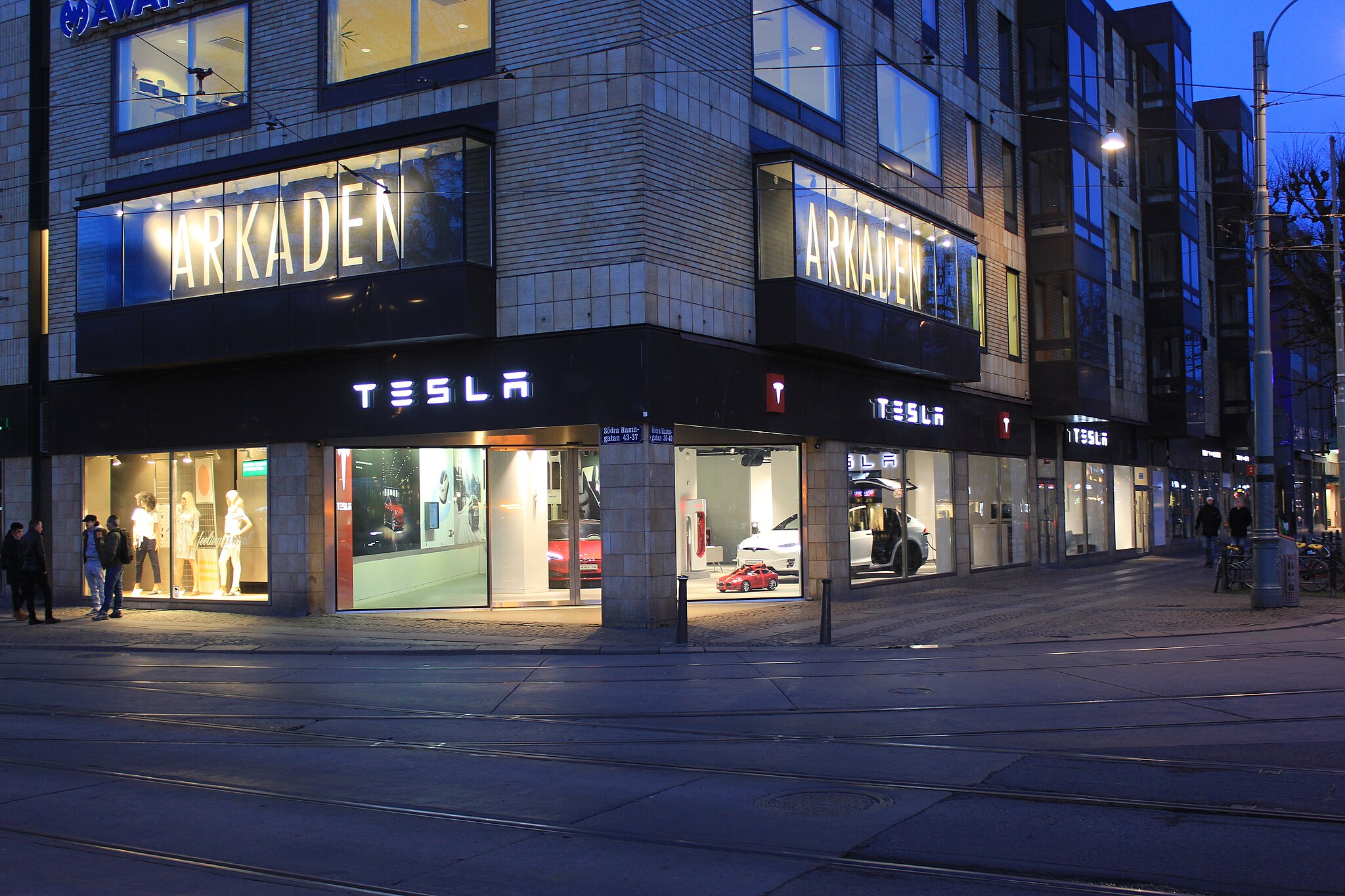
Two years into their postal blockade, Swedish unions are outraged that Tesla is still able to provide its customers’ vehicles with valid plates through various clever workarounds.
Seko chairman Gabriella Lavecchia called it “embarrassing” that the world’s largest EV maker, owned by CEO Elon Musk, refuses to simply roll over and accept the unions’ demands.
Unions shocked Tesla won’t just roll over and surrender
The postal unions’ blockade began in November 2023 when Seko and IF Metall-linked unions stopped all mail to Tesla sites to force a collective agreement. License plates for Tesla vehicles instantly became the perfect pressure point, as noted in a Dagens Arbete report.
Tesla responded by implementing initiatives to work around the blockades. A recent investigation from Arbetet revealed that Tesla Sweden is now using dozens of private residences, including one employee’s parents’ house in Trångsund and a customer-relations staffer’s home in Vårby, as a way to obtain license plates for its vehicles.
Seko chairman Gabriella Lavecchia is not pleased that Tesla Sweden is working around the unions’ efforts yet again. “It is embarrassing that one of the world’s largest car companies, owned by one of the world’s richest people, has sunk this low,” she told the outlet. “Unfortunately, it is completely frivolous that such a large company conducts business in this way.”
Two years on and plates are still being received
The Swedish Transport Agency has confirmed Tesla is still using several different workarounds to overcome the unions’ blockades.
As noted by DA, Tesla Sweden previously used different addresses to receive its license plates. At one point, the electric vehicle maker used addresses for car care shops. Tesla Sweden reportedly used this strategy in Östermalm in Stockholm, as well as in Norrköping and Gothenburg.
Another strategy that Tesla Sweden reportedly implemented involved replacement plates being ordered by private individuals when vehicles change hands from Tesla to car buyers. There have also been cases where the police have reportedly issued temporary plates to Tesla vehicles.
News
Czech Deputy excited for Tesla FSD, hints at Transport Committee review
The ANO party lawmaker shared his thoughts about FSD in a post on social media platform X.
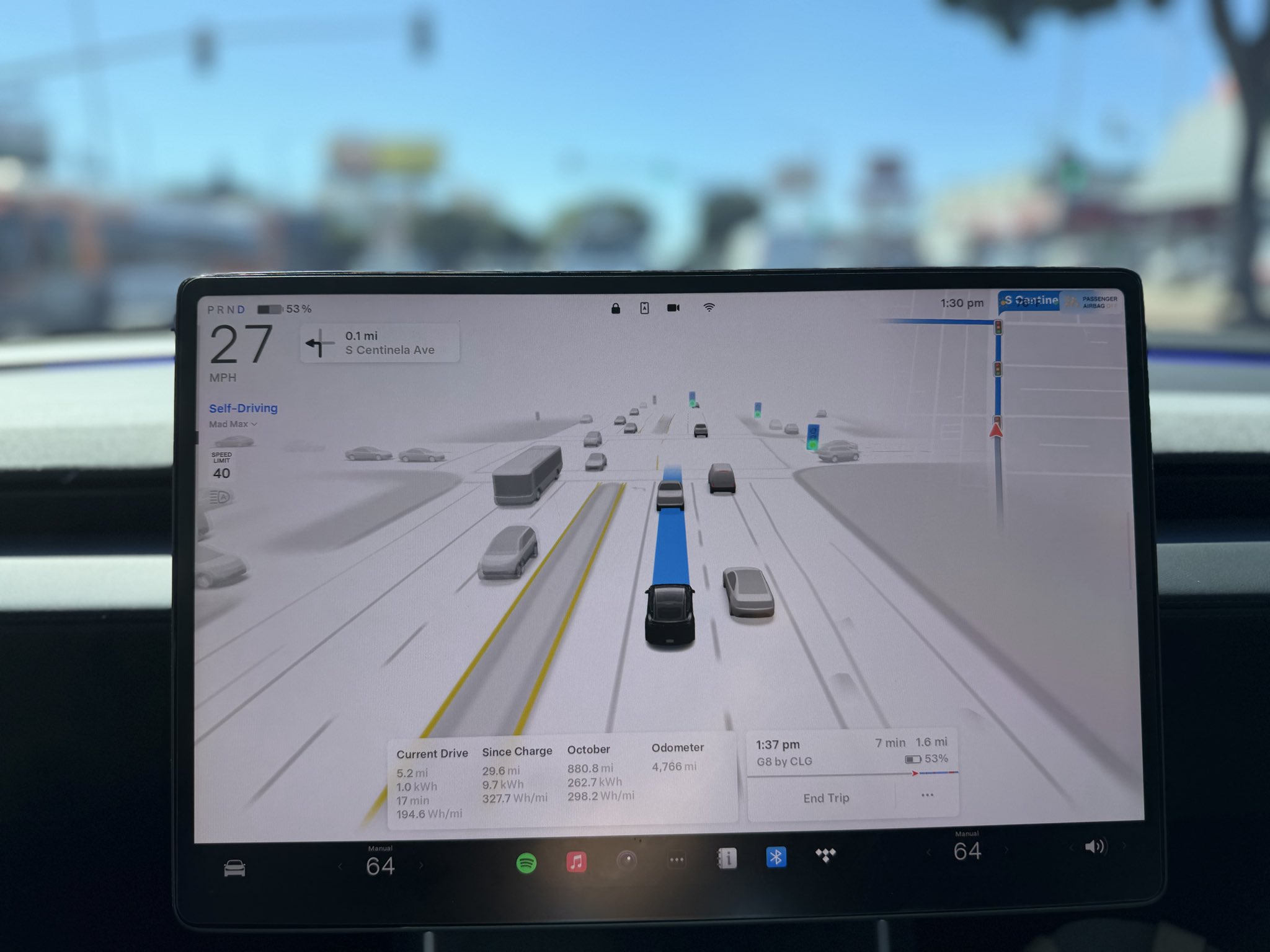
Martin Kolovratník, a Czech Republic Chamber of Deputies member, has expressed his excitement for Tesla’s Full Self-Driving (FSD) after an apparent constituent called for a quick approval for the advanced safety system.
The ANO party lawmaker, who drives both diesel and EV, shared his thoughts about the matter in a post on social media platform X.
The official’s initial statements
Kolovratník kicked off the exchange with a post outlining his coalition’s efforts to scrap highway toll exemptions for electric vehicles and plug-ins starting in 2027.
“Times have changed. Electric vehicles are no longer a fringe technology, but a full-fledged part of operations. And if someone uses the highway network, they should follow the same rules as everyone else. That’s the basis of fairness,” he wrote.
He emphasized equity over ideology, noting his personal mix of diesel and electric driving. “For this reason, there is no reason to continue favoring one technology at the expense of another… It’s not about ideology, it’s about equal conditions. That’s why we clearly agreed within the new coalition: the exemption for electric vehicles and plug-ins will end in 2027. The decision is predictable, understandable, and economically sound.”
Tesla FSD enthusiasm
The conversation pivoted to Tesla’s FSD when X user @robotinreallife, who seems to be one of the official’s constituents, replied that other matters are more important than ending highway exemptions for EVs.
“I’m happy to pay for the highway, but I have a question about a much more fundamental matter: The Netherlands will approve the operation of Tesla FSD in February 26, a technology that has been proven to reduce accidents. The Czech Republic has the option to immediately recognize this certification. Do you plan to support this step so that we don’t unnecessarily delay?” the X user asked.
Kolovratník responded promptly, sharing his own excitement for the upcoming rollout of FSD. “I know about it. I like it and it seems interesting to me. Once we set up the committees and subcommittees, we’ll open it right away in that transport one. Thanks for the tip, I’ll deliver the report,” the official noted in his reply on X.
Kolovratník’s nod to FSD hints at the system’s potentially smooth rollout to Czechia in the coming year. With the Netherlands possibly greenlighting FSD (Supervised) in early 2026, Kolovratník’s commitment could accelerate cross-border certification, boosting FSD’s foray into Europe by a notable margin.
News
Tesla Model 3 named New Zealand’s best passenger car of 2025
Tesla flipped the switch on Full Self-Driving (Supervised) in September, turning every Model 3 and Model Y into New Zealand’s most advanced production car overnight.

The refreshed Tesla Model 3 has won the DRIVEN Car Guide AA Insurance NZ Car of the Year 2025 award in the Passenger Car category, beating all traditional and electric rivals.
Judges praised the all-electric sedan’s driving dynamics, value-packed EV tech, and the game-changing addition of Full Self-Driving (Supervised) that went live in New Zealand this September.
Why the Model 3 clinched the crown
DRIVEN admitted they were late to the “Highland” party because the updated sedan arrived in New Zealand as a 2024 model, just before the new Model Y stole the headlines. Yet two things forced a re-evaluation this year.
First, experiencing the new Model Y reminded testers how many big upgrades originated in the Model 3, such as the smoother ride, quieter cabin, ventilated seats, rear touchscreen, and stalk-less minimalist interior. Second, and far more importantly, Tesla flipped the switch on Full Self-Driving (Supervised) in September, turning every Model 3 and Model Y into New Zealand’s most advanced production car overnight.
FSD changes everything for Kiwi buyers
The publication called the entry-level rear-wheel-drive version “good to drive and represents a lot of EV technology for the money,” but highlighted that FSD elevates it into another league. “Make no mistake, despite the ‘Supervised’ bit in the name that requires you to remain ready to take control, it’s autonomous and very capable in some surprisingly tricky scenarios,” the review stated.
At NZ$11,400, FSD is far from cheap, but Tesla also offers FSD (Supervised) on a $159 monthly subscription, making the tech accessible without the full upfront investment. That’s a game-changer, as it allows users to access the company’s most advanced system without forking over a huge amount of money.
